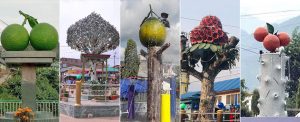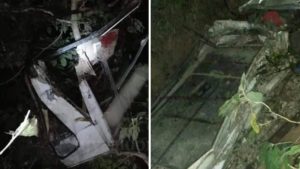
Anita Kusari, a previous resident of Banphikot rural municipality-8 in Rukum, has been living in Tulsipur of Dang for three years now. Her husband is employed in the USA. Her two sons, nephew, and sister-in-law live in a rented house in Tulsipur-6. She migrated to Dang for better education opportunities for her children and enrolled the four in a nearby boarding school. However, she feels the opportunities and facilities in Tulsipur have not met her expectations.
“The quality of education is not good enough. Even if children write incorrect spellings, they are not corrected but rather praised falsely,” she says, “We migrated to the city for quality of education. But what will happen to the future of these children, if their education is ruined early? Other facilities are also not satisfactory.”
Tikaram KC of Bagchaur municipality-11 in Salyan has been running a clothing store in Tulsipur Bus Park for some 25 years. He provides for a family of 13 people from the same store, but lately, with more stores opening in the area, the business is not the same.

“After the lockdown, business has not been good and the competition too has increased in the market. Earlier, people (travellers) used to stay in Tulsipur overnight and return to their villages after shopping. Now they directly travel from Nepalgunj and that’s why there is no profit in a stable business.”
Established in 2016, some 430 kilometres away from Kathmandu, Tulsipur sub-metropolitan city covers an area of 384 square kilometres. Its total population is around 150,000, out of which a significant population migrated to Tulsipur from nearby hilly districts over the past decade.
Workers come from other parts of the country and Uttar Pradesh of India for seasonal work and business in Tulsipur. But with the population ever-growing, locals here express dissatisfaction about the city’s status, which experts say is the result of a lack of data-driven plans and policies.
High number of temporary residents

The number of people migrating from the mountainous district has increased in Tulsipur for a few years now. The flow of residents of the Salyan, Rukum, and Pyuthan districts is more common in the Tulsipur Bus Park area. They enjoy the services and pay taxes as per the rules and go to their villages only during emergencies, elections, or special occasions.
This can be seen in a comparison between the census data and the city’s voter roll. “The census record is higher than the number of voters because of temporary residents,” says Kamala Devi Lamichhane, a lecturer at the Central Department of Population Studies at Tribhuvan University, “They don’t vote, but the municipality still requires to provide services, making proper planning a problem.”
In the span of mid-April 2017 to mid-April 2022, 18,402 people migrated into Tulsipur while 8,346 people migrated out from the city. According to the city’s Civil Registration Officer Krishna Bahadur Wali, there are many more who have migrated without proper paperwork. “They tend to go through the official paperwork only when they need the migration certificate,” he says, “And more people come for temporary residence for business, education and other services, more than what we have estimated. So we do not have the accurate number.”
Tulsipur Mayor Tikaram Khadka says it is difficult to get the right count of the population as some families have dual residency statuses. “There are families who have residencies in two places–say Rukum and Tulsipur–at the same time. While half of the family might live here, the other half might live in the village, somewhere else.”
He adds, “Based on citizenship, the Land Revenue Office gives residency to people where they are located so we see dual residencies there. When it comes to land registration, the same house might be registered in two different places. And it hampers the data we collect, and also impacts the access to services.”
Ward 5 secretary Sanjay Kumar Gupta says, “Such people are greater in our ward than any other wards. We only have 5,900 names on our voter’s list, but the population that lives here is over 20,000.”
Dissastisfactions galore

In the absence of clear data on temporary residents, problems have arisen in the city in different sections. For the growing population, the roads, sewage system and electricity along with other infrastructures are proving to be insufficient in Tulsipur. The inner roads of wards 5 and 6 of the city have grown smaller. And the pavement is full of vendors, rendering it useless for pedestrians.
The drinking water supply is not regular around the year while the sewage runs openly and even mixes into the nearby Patu Khola, polluting it more. And the roads are just buried under the sludge and plastics. In the name of public transportation, Tulsipur has tuk-tuks (autorickshaws) that charge people rampantly. There are 170 educational institutions including one university and 192 health services including hospitals.
“But what will the numbers alone do? Where is the quality? The services are used by the middle-class families whereas the affluent classes go to Kathmandu or India for quality education and health services,” laments Dev Raj Dhital, a former civil servant residing in Tulsipur-6.
The growth in temporary residents also poses problems for security management, shares Wali. “If someone commits a crime in our city and they are registered in another city, their actual identity and details are not revealed, so accountability decreases a lot.”

Ward 5 secretary Gupta says, “There is also no definite data on how many households there are in our ward, it is estimated that there are around 3,000 households. But there is no free space left, the land is all covered with houses. And, the traffic is increasing.”
Gupta says that the provincial and federal governments need to be more active in managing the problems and providing easy access to services to the increasing population. “As the population increases, waste also increases and there should be proper waste management and sewage management.”
He adds, “We have many streams here and the sewage ultimately ends up in fields. The federal or provincial government needs to look at this issue, the local government alone cannot handle it.”
Need for data and management
Various departments of the Tulsipur sub-metropolitan government are taking some initiatives. Departments including registration, planning and evaluation, revenue, women and children, education, and health, are collecting data through their systems.
Data collection is there but their management is a different case. Information Officer Baburam Neupane says the city has not made plans based on the data either.
“Firstly, there is a huge gap between the data we are only putting together and the data provided by others. Secondly, we have not been able to use the data that we have and then adapt it to our plans according to the importance and necessity of the people. We have been analysing and distributing the data to service other recipients and organisations on demand for the common good.”
Tulsipur’s Chief Administrative Officer Mohan Poudel admits the city has not based its projects on data. He adds, “We cannot create a unified network of the programmes and development plans backed by data. We have various data, from different fields, but they are not organised. We have not been able to document the information on temporary residences or their dual residencies. So it definitely affects our planning and development projects.”
Efforts are being made to bring all the data into a single Integrated Data Management System (IDMS) programme that is being brought into implementation with the help of Asia Foundation, he adds. A digital map was also created in mid-2022. Mayor Khadka says that other local bodies have not understood this concept.

“We created Nepal’s first digital map. Nobody understood it, neither the land revenue nor the survey department. Even when we tried to teach them how to use the digital map, to allocate the land, they could not follow the process. It is not possible for us to think to give digital services if officials cannot even read the map. So the office has reverted back to the old system.”
Proper records: Next focus
Mayor Khadka has envisioned a 100-year development model. But will the model be based on data or estimation? Khadka answers with a question, “Should the federal government be more responsible and provide us with models of the city or not? We want to follow the appropriate model given by them. And we want to create infrastructure, roads, sewage, and residential areas that will last for a hundred years.”
Meanwhile, efforts for a programme related to waste management based on facts and figures are underway in Tulsipur.

“Our commitment to the programme was based on who could help us more and who could work together efficiently, and be more integrated into the project,” says programme coordinator Govinda Bahadur Basnet. “We are gathering data on waste collection and producing compost based on it. Even though we are disposing of the non-decomposable waste, we will soon manage it as well. Employees of all departments have been given their user names and passwords for access.”
When data is kept organised, employees believe it will positively impact the smooth services of water supply, transportation, housing, waste management, roads, and sewage system. “If we can just set up the government-proposed data management system, and address the dual residency data, it will be very effective,” says Jharendra Kharel the city’s chief of the meeting management department and tourism & culture department.
If someone resides in any place for more than six months, they must be counted as the population of the same place even if they are originally from somewhere else. However, as local authorities have not collected or maintained the data, the plans are not being made based on it, hence, hampering their sustainable development.
It is the initial phase of the IDMS programme implementation and so it will be easy for collecting authorised information from the officers. “There was a little confusion at the beginning because it was a new system. However, it has been a month and the IDMS has been a great help in data collection as well,” says Neupane.
Regardless, Lamichhane highlights there is still no practice of surveys and comprehensive analysis focused on overall migration trends. “Even though the National Statistics Office (the erstwhile Central Bureau of Statistics) has sporadic data on migration, no agency has conducted a comprehensive survey. Only when the local governments are used for this, then only, the real data will come out and it will also be reliable.”
This story was translated from the original Nepali version and edited for clarity and length.




















